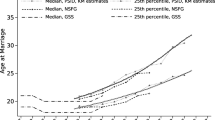Abstract
This article documents the size and growth of the black middle class at the beginning of the 21st century, analyzing data from the US Census and the Current Population Survey on income, occupations, and education. We examine barriers to further growth of the black middle class, assessing theories of marriageability and imbalances in the numbers of college-educated black men and women. We also document the consequences of low marriage and cohabitation rates for the growth of the black middle class, and show that there are relatively high rates of intergenerational downward mobility among affluent black families.
Similar content being viewed by others
References
Biddlecom, A. and Kramerow, E. (1998). Household headship among married women: The roles of power, education, and convention. Journal of Family and Economic Issues, 19 (4), 367–382.
Chiswick, B. (1977). Sons of immigrants: Are they at an earnings disadvantage? American Economic Review, 67, 376–80.
Conley, D. (1999). Being Black, living in the red. Berkeley: University of California Press.
Davis, T. J., Jr. (1995). The occupational mobility of Black males revisited: Does race matter? The Social Science Journal, 32, 121–135.
Duncan, G. J., Boisjoly, J. and Smeeting, T. (1996). Economic mobility of young workers in the 1970s and 1980s. Demography, 33 (4), 497–509.
Duncan, O.D. (1968). Patterns of occupational mobility among Negro men. Demography, 5 (1), 11–22.
Goldscheider, F.K. and Waite, L.J. (1986). Sex differences in the entry into marriage. American Journal of Sociology, 92, 91–109.
Graham, L.O. (1995). Member of the club. New York: Harper Collins.
—————. (1999). Our kind of people. New York: Harper Collins.
Greene, J. and Forster, G. (2003). Public high school graduation and college readiness rates in the United States. Education Working Paper #3. New York: The Manhattan Institute.
Grodsky, E. & Pager D. (2001). The structure of disadvantage: Individual and occupational determinants of the Black-White wage gap. American Sociological Review, 66(August), 542–567.
Hacker, A. (1992). Two nations: Black and White, separate, hostile, unequal. New York: Ballantine Books.
Halle, D. (1984). America’s working man. Chicago: University of Chicago Press.
Holzer, H.J. (1996). What employers want: Job prospects for less educated workers. New York: Russell Sage Foundation.
Hout, M. (1984). Occupational mobility of Black men: 1962 to 1973. American Sociological Review, 49 (3), 308–322.
Kalmijn, M. (1996). The socioeconomic assimilation of Caribbean American Blacks. Social Forces, 74 (3), 911–930.
Landry, B. (1987). The new Black middle class. Berkeley: University of California Press.
Lee, J., Neckerman, K., & Carter P. (1999). Segmented assimilation and minority cultures of mobility. Ethnic and Racial Studies, 22 (6), 945–965.
Lichter, D.T. (1990). Delayed marriage, marital homogamy and the mate selection process among white women. Social Science Quarterly, 71, 802–11.
Lichter, D.T, McLaughlin, D.K., Kephart G., and Landry, D.J. (1992). Race and the retreat from marriage: A shortage of marriageable men? American Sociological Review, 56, 15–32.
Lindberg, L., Nathanson, C., Pleck J., & Wolpin, K. (1997). Integrating theoretical perspectives on gender, union formation and fertility. Washington DC: Urban Institute. Retrieved March 2, 2004, from http://fatherhood.hhs.gov/CFSForum/apenb.htm.
Lowry, G.C. (2002). The Anatomy of racial inequality. Cambridge: Harvard University Press.
Lucas, S. R. (1999). Tracking inequality. New York: Teachers College Press.
Mare, R.D. (1991). Five decades of assortative mating. American Sociological Review, 56, 15–32.
McCall, L. (2001). Sources of racial wage inequality in metropolitan labor markets: Race, ethnic and gender differences. American Sociological Review, 66, 520–541.
McWhorter, J. (2001). Losing the race: Self-sabotage in America. New York: Harper Collins.
Moss, P. and Tilly, C. (1996). Soft skills and race: An investigation of Black men’s employment problems. Work and Occupations, 23, 252–76.
Murnane, R., Willett, J. & Levey, F. (1995). The growing importance of cognitive skills in wage determination. Review of Economics and Statistics, LXVII (2), 251–266.
Neal, D.A. and Johnson, W.R. (1996). The role of premarket factors in Black-White wage differences. Journal of Political Economy, 104 (5), 869–895.
Newman, K. S. (1985). Falling from grace: The experience of downward mobility in the American middle class. New York: Vintage Books.
Ogbu, J. (2003). Black American students in an affluent suburb. Mahwah NJ: Lawrence Erlbaum.
Oliver, M. & Shapiro, T. (1995). Black wealth, White wealth. New York: Routledge.
O’Neill, J. (1990). The role of human capital in earnings differences between Black and White men. Journal of Economic Perspectives, 4 (4), 25–45.
Oppenheimer, V. (1994). Women’s rising employment and the future of the family in industrialized societies. Population and Development Review, 20, 293–342.
Patillo-McCoy, M. (1999). Black picket fences: Privilege and peril among the Black middle class. Chicago: University of Chicago Press.
Portes, A. & Zhou, M. (1993). The new second generation: Segmented assimilation and its variants. Annals of the American Academy of Political and Social Science, 553, 74–96.
Portes, A. and R. Rumbaut. (2001). Legacies: The story of the immigrant second generation. Berkeley: University of California Press.
Qian, Z. (1998). Changes in assortative mating: The impact of age and education, 1970–1990. Demography, 35 (3), 279–292.
Raymo, J. & Xue, Y. (2000). Temporal and regional variation in the strength of educational homogamy. American Sociological Review, 65, 773–780.
Smits, J., Ultree W., & Lammes, J. (1998). Educational Homogamy in 65 Countries. American Sociological Review, 63, 264–285.
Steele, C. & Aronson, J. (1998). Stereotype threat and the test performance of academically successful African Americans. In C. Jencks and M. Phillips (eds.). The Black-White test score gap. Washington DC: Brookings Institution.
Thernstrom, S. (1997). American in Black and White: One nation indivisible. New York: Simon and Schuster.
Wilson, W.J. (1987). The Truly Disadvantaged. Chicago: University of Chicago Press.
Zhou, M. (1997). Segmented assimilation: issues, controversies, and recent research on the new second generation. International Migration Review, 31, 975–1008.
Author information
Authors and Affiliations
Rights and permissions
About this article
Cite this article
Attewell, P., Domina, T., Lavin, D. et al. The black middle class: Progress, prospects, and puzzles. Journal of African American Studies 8, 6–19 (2004). https://doi.org/10.1007/s12111-004-1001-5
Published:
Issue Date:
DOI: https://doi.org/10.1007/s12111-004-1001-5




